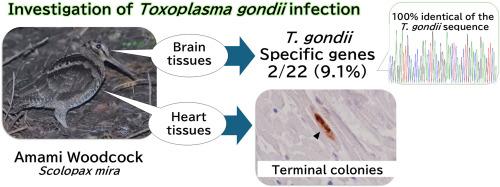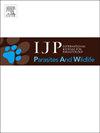Toxoplasma gondii infection in the endangered Amami Woodcock, Scolopax mira (Aves: Charadriiformes)
IF 2.2
3区 医学
Q3 ECOLOGY
International Journal for Parasitology-Parasites and Wildlife
Pub Date : 2025-09-09
DOI:10.1016/j.ijppaw.2025.101135
引用次数: 0
Abstract
Toxoplasma gondii is a parasitic protozoan for which family Felidae serves as the definitive hosts. In regions where native felids are absent, introduced domestic cats (Felis catus) act as reservoirs of T. gondii, posing a threat of infection to various wildlife population. A population of feral cats has been identified on Amami-Oshima Island located in the southern part of the Japanese Archipelago, and molecular examination confirmed that the T. gondii they harbour has spread to endemic mammals. In this study, we aimed to detect T. gondii in the Amami Woodcock (Scolopax mira), a bird species endemic to Amami-Oshima Island. DNA was extracted from the brain tissue of twenty-two birds, and molecular detection of T. gondii was performed using a commercial T. gondii detection kit based on real-time polymerase chain reaction. Two birds (9.1%) tested positive. The determined nucleotide sequences were 100% identical to that of the T. gondii reference sequence. Histopathological examination and ultrastructural analyses revealed terminal colonies in the cardiomyocytes of one bird, which were immunohistochemically confirmed as T. gondii. Here, we report the first record of T. gondii infection in the Amami Woodcock. Given its endangered status, ongoing research on the prevalence and pathogenicity of T. gondii is warranted.

濒临灭绝的麻蚶刚地弓形虫感染情况(鸟类:charadriiforma)
刚地弓形虫是一种寄生原生动物,其科Felidae作为最终宿主。在没有本地猫科动物的地区,引进的家猫(Felis catus)是弓形虫的宿主,对各种野生动物种群构成感染威胁。在日本群岛南部的奄美大岛上发现了一群野猫,分子检查证实它们所携带的弓形虫已经传播到当地的哺乳动物身上。本研究目的是在奄美大岛特有鸟类奄美伍德考克(Scolopax mira)中检测弓形虫。从22只鸟的脑组织中提取DNA,采用基于实时聚合酶链反应的商品化弓形虫检测试剂盒进行弓形虫分子检测。两只鸟(9.1%)检测呈阳性。测定的核苷酸序列与弓形虫参考序列完全一致。组织病理学检查和超微结构分析显示,1只鸟心肌细胞中有末端菌落,免疫组织化学证实为弓形虫。在这里,我们报告了第一次记录弓形虫感染的阿米伍德科克。鉴于弓形虫的濒危状况,有必要对其流行率和致病性进行持续研究。
本文章由计算机程序翻译,如有差异,请以英文原文为准。
求助全文
约1分钟内获得全文
求助全文
来源期刊

International Journal for Parasitology-Parasites and Wildlife
Medicine-Infectious Diseases
CiteScore
3.80
自引率
5.60%
发文量
113
审稿时长
45 days
期刊介绍:
The International Journal for Parasitology: Parasites and Wildlife (IJP-PAW) publishes the results of original research on parasites of all wildlife, invertebrate and vertebrate. This includes free-ranging, wild populations, as well as captive wildlife, semi-domesticated species (e.g. reindeer) and farmed populations of recently domesticated or wild-captured species (e.g. cultured fishes). Articles on all aspects of wildlife parasitology are welcomed including taxonomy, biodiversity and distribution, ecology and epidemiology, population biology and host-parasite relationships. The impact of parasites on the health and conservation of wildlife is seen as an important area covered by the journal especially the potential role of environmental factors, for example climate. Also important to the journal is ''one health'' and the nature of interactions between wildlife, people and domestic animals, including disease emergence and zoonoses.
 求助内容:
求助内容: 应助结果提醒方式:
应助结果提醒方式:


